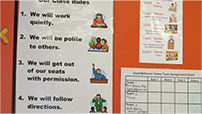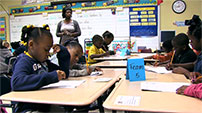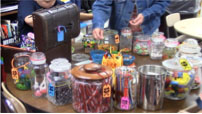
About the Game
The Good Behavior Game is a classroom management strategy that promotes positive behavior and has shown positive long-term impacts for students.
How it Works
The Good Behavior Game helps teachers keep focused on managing their classrooms and helps children take ownership for their own behavior. I know that if there is good behavior in the classrooms then I’m not going to have to worry about disciplining children outside of the classroom.
PrincipalBaltimore City Public Schools
Teachers play the game with their class while students are completing independent or group assignments in small teams. Students learn teamwork; they receive positive reinforcement for promoting and following classroom rules; and they practice monitoring and managing their own behavior.
While the Good Behavior Game is played, teachers monitor teams to ensure they are following each of the class rules. If team members break a rule, that team receives a check mark. Teams that receive four or fewer check marks win the game and receive positive reinforcement to encourage future success.
The game is not a curriculum and does not compete with instructional time. In the beginning of the school year the Good Behavior Game is intended to be played three times a week for approximately 10 minutes at time. At the end of the school year, a teacher may play the game daily for up to 30 or 40 minutes.
Core Elements
The Good Behavior Game is built around four core elements.
-
1 Classroom Rules

During the Good Behavior Game, students follow four straightforward classroom rules. These rules provide students with clear expectations, helping them internalize the behaviors that will allow them to be successful in school.
-
2 Team Membership

Students play the game in teams that are balanced by behavior, gender, and academic ability. Team membership helps students develop relationships with peers who can reinforce expectations and support one another to win the game as a team.
-
3 Monitoring Behavior

Teachers monitor student behavior noting incidents where a classroom rule is not followed. Students practice monitoring their own behavior and behavior of teammates, enabling teachers and students to reinforce expectations and positive team behaviors.
-
4 Positive Reinforcement

Positive reinforcement is used throughout the Good Behavior Game to strengthen desired behavior of individuals and the group. This encourages students to repeat productive behaviors, enabling teachers to acknowledge and focus on students’ efforts.
History & Theory of the GBG
The Good Behavior Game is grounded in two theories: Life Course/Social Field Theory and Behavior Theory. These theories serve as the foundation for the game and provide support for the program’s effectiveness.
-
Life Course/Social
Field TheoryThis theory holds that as we progress through life, we meet people who serve as “natural raters.” These people help identify what tasks or behaviors are expected of us and how well we are performing these tasks. In a school, these natural raters are teachers and peers who help students determine what skills they must acquire to be successful in the classroom for future success. Skills learned in one social field such as the classroom help students to be successful in other social fields such the workplace.
-
Social
Adaptation Positive
Reinforcement Generalization
of Mastery Interdependent
Group Contingency
-
Behavioral Theory
Interdependent group theory explains that a group cannot succeed without the cooperation of each individual. This means all students in a group must meet a standard for the group to succeed. According to behavior theory, one way to improve behavior is through positive reinforcement. Positive reinforcement may be used in the Good Behavior Game in the form of tangible (stamps, stickers) or intangible (activities) rewards.
Frequently Asked Questions
-
GENERAL
-
What is the Good Behavior Game?
The Good Behavior Game is a team-based classroom behavior management strategy which helps children master the role of student and be successful at the key demands of the classroom.
-
Why play the Good Behavior Game?
The Good Behavior Game is an evidence-based intervention. In the short term, the game helps reduce aggressive and disruptive behavior in the classroom and over time, these same students are less likely to be referred for academic or behavioral services, to misuse drugs and alcohol, and have lower rates of suicidal idealization, depression, and incarceration than their peers who did not play the game.
-
Why play the Good Behavior Game in first grade?
The Good Behavior Game is designed to help socialize children into the role of student. The game helps early learners develop skills such as concern for peers, sitting still, paying attention, and completing school work that will provide a foundation for success throughout their schooling and into early adulthood.
-
Why use a classroom-based intervention?
The Good Behavior Game is a universal intervention designed to be played with all students. By integrating the game into a regular classroom routine, students internalize expected classroom behaviors and begin to apply them throughout the day. While the Good Behavior Game is beneficial to all students in the classroom, it is of particular benefit to male students already showing signs of aggressive/disruptive behavior when they enter the first grade.
TRAINING & SUPPORT
-
What does Good Behavior Game training include for teachers?
Good Behavior Game training includes three days of face-to-face training, ongoing coaching throughout the school year, and all of the materials needed to play the Game.
-
How do you become a Good Behavior Game coach?
Good Behavior Game coaches must have a master's degree or higher in education or a related area; five or more years of experience as a teacher; and two years of experience as a teacher leader, school coach or mentor. Good Behavior Game coaches are generally hired by the state or district education agency through which the game is being implemented and often have the opportunity to become local Good Behavior Game trainers over time.
-
Who do I contact to find out more?
Interested to learn more? Ready to start discussions of how Good Behavior Game could fit the needs of your classroom, school, district, or state? Contact us!
-
-
IMPLEMENTATION
-
How is the Good Behavior Game played?
The Good Behavior Game is played in teams while the students are working together on independent assignments or collaboratively. Students adhere to four classroom rules while teachers monitor students and students monitor both their own behavior and that of their teammates.
-
Can the Good Behavior Game be played outside the classroom?
The Good Behavior Game can be played anywhere. Most teachers begin to play the Game in the classroom to set their students up for success, but over the course of the year, it can become an effective tool in managing student behavior in the lunchroom, in the hallways, on field trips, or at any other point in the day where teachers seek to clarify student expectations.
-
How does the Good Behavior Game fit with what I already do in my classroom or in my district?
The Good Behavior Game is a strategy, not a program. As a result, playing the game does not take time away from instruction. In fact, research shows that playing the Good Behavior Game actually leads to increased instructional time for most teachers. The game is a universal intervention that easily pairs with more targeted and intensive interventions as part of a tiered intervention framework. It can be used in concert with additional individualized strategies or as a standalone strategy designed to be of benefit to the whole class.
-
When will I see results?
Teachers who play the Good Behavior Game in their classroom have reported a reduction in disruptive and off-task behavior, increased time to teach, and greater job satisfaction by the end of the year. Student outcomes of the Good Behavior Game can be seen as early as first grade and continue into early adulthood. Learn more about the impacts of the Game.
-
Why is the game played on teams?
The Good Behavior Game is played on teams to help students connect with peers and skills to monitor their own behavior as well as the behavior of others.
-
What is positive reinforcement?
Positive reinforcement encompasses encouragement, praise, or other tangible and intangible reinforcers designed to encourage positive behaviors.
-
Isn’t the Good Behavior Game punitive for the students who lose?
The Good Behavior Game is set-up to facilitate student success. Positive reinforcement is provided on both a daily and weekly basis in an effort to ensure that all students receive positive reinforcement to play the Game each week. At the beginning of the year, teachers play under circumstances that are most likely to lead to all student teams winning the Game. Teachers make the game more challenging as students demonstrate mastery expectations. When students do not win, teachers do not draw attention to the loss, instead focusing on celebrating the successes of the winning teams and reminding all students that they will have another opportunity to win soon.
-

